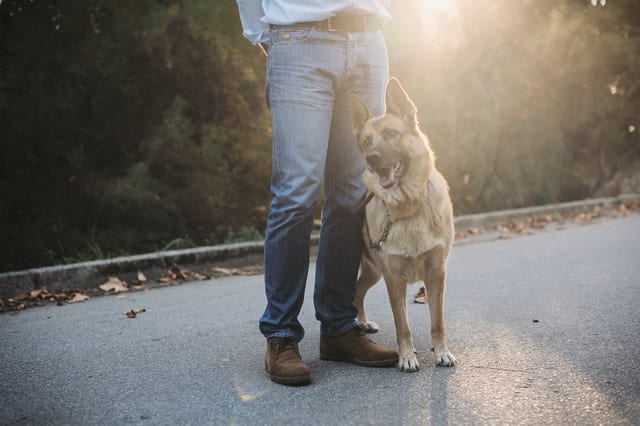
Beginners should remember to start educating their dogs when they are still puppies. In fact, if the animal begins to acquire negative habits, it will be more difficult to eliminate them in the future.
It is not necessary to take a course or become a dog trainer to educate your pet. In this article we present some tips and essential steps for a good dog education if you are a beginner .
Factors to consider for dog training for beginners
If you are adopting a dog for the first time or if you want to teach a command to another animal you have just adopted but have never done before, don’t worry!
You don’t need to become a professional trainer . If you are new to the world of dogs, here are some tips to keep in mind:
- Guarantee the animal its basic needs (food, health, hygiene, shelter).
- Know and understand your animals.
- Let them come into contact with other animals.
- Reward their fair conduct and avoid punishment.
- Give him love and companionship .
- Play sports with your dogs or go out at least once a day for a walk.
Dog education for beginners: puppies
It could be said that it is easier to train a puppy dog than an adult one, although there are always exceptions . If you want to start educating a dog for the first time, you should proceed as soon as possible.
In this way, you will prevent your pets from acquiring unhealthy habits which will then repeat themselves every day and will therefore be more difficult to eliminate.
1. Training is essential
Bear in mind that dogs are very intelligent animals, but they need some training to adopt and maintain a habit . For this purpose, we recommend that you dedicate yourself to the education of your dogs every day, even if only for a few minutes. Until they have mastered a command perfectly, don’t move on to the next lesson .
2. Balance training and games
Dogs love to play and have fun, whether alone or with their owners or other animals. For this reason, with regard to the education of dogs for beginners, it is advisable to balance the moments of training and those of leisure .
If you can achieve a balance between the two moments, the animal will learn faster. On top of that, it will consume a lot of energy, which is why it will rest for a longer number of hours and not behave badly. Many times the “pranks” are the consequence of little movement or physical activity .
3. Physical activity
In relation to the previous point, another piece of advice that can be of great use, and which is often overlooked, concerns physical activity. A dog that has been running, playing, jumping and walking for several minutes a day will be more tired and calmer when they get home.
There is no reason to exhaust it, this is clear, but to make sure that they discharge the accumulated energies. Also take into account age and breed, as a brachycephalic or senior dog is likely to tire sooner than a puppy or Dalmatian.
4. Maintain a positive attitude
Another tip in dog training for beginners concerns the attitude of the owner. If you are prepared to educate them and have fun in the meantime, the animals respond positively.
For this reason, if one day you are sick, tired or in a bad mood, perhaps it is better to postpone the lesson . Expect to have all the energy and attention needed for training. This way, you will get better results.
5. Dog training for beginners: be patient
Another virtue that you will need to work on before training your pets is the commitment, perseverance and patience you reserve for this task . An animal does not learn overnight, just as a child does not learn to walk overnight.
It is therefore essential to remain calm and not strain when something is not going as expected . With love and taking your time, you will see that your pets will respond positively to you and carry out all the commands, tricks and teachings you have given them.
And finally, don’t forget about the rewards. They don’t have to be expensive (like a toy) or edible ( biscuits , snacks, treats, a bone), but they must serve to show the dog that we are proud of him. A caress or a sweet word is enough!
Educating or training a dog: what’s better?
These are two different practices, both useful and complementary. Whether you choose to educate or train a dog, the use of positive reinforcement is always recommended.
Although they are often used interchangeably, when we talk about raising or training a dog we are not talking about the same thing.
Educating or training a dog: what’s better? We talk about it in this article.
Differences between educating or training
First of all, it is important to understand how the two terms differ, since they are often incorrectly used to indicate the same practice. There is a difference between educating and training a dog . To understand it, we first report the lexical meaning of the two words:
- Educate : allows the development of certain faculties including the rules of coexistence, respecting those around us.
- To train : to teach the animal to perform some movements or skills useful to carry out the orders of its owner or another person in charge ( the trainer ).
If we consider these definitions we could be led to think that it is much better for a dog to receive training than education, since the latter seems to be reserved for humans. Yet even dogs are capable of learning education; and the younger they are when we teach them, the more receptive they are.
We cannot forget how teaching must be based on motivation and “reinforcement” or, in other words, in repeating the lessons with a certain frequency to avoid them being forgotten. In training, on the other hand, responsibility and commitment play a very important role, since to obtain appreciable results it is often important to resort to the support of a professional.
So, to educate or train a dog? What is better? The answer is … both! These are not incompatible practices, but rather deeply interconnected. Certainly different, but complementary.
A good trainer can get a dog, whether it’s a Shih Tzu or a Labrador Retriever, learning actions like sitting or not pulling on the leash when out for a walk. Through education, however, the owner can achieve excellent results from a social point of view; that he socializes with his fellow creatures in the park, that he doesn’t try to get on the table to eat or that he doesn’t suffer when he is alone in the house.
A bad training or a lack of education are harmful in the same way . What must take precedence in both cases is the integrity of the animal and, above all, that it is enabled to develop its full potential. Making sure that they give their all and live a happy life should be our goal and our pride.
Positive reinforcement
Much has been said about the various types of training or education to which our four-legged friend should be subjected. The latest “trend” states that , to achieve good results and avoid trauma in animals, teaching through positive reinforcement turns out to be the most appropriate.
This means not to use physical violence (such as punches or kicks) or psychic (shouts) for any reason during learning. There are much more effective techniques based on giving direct orders and giving rewards in the form of food, compliments, strokes or toys.
While education teaches the dog to coexist in society, training allows him to obey specific orders. Educating or training a dog is a very common doubt among puppy owners and, in principle, the education is done at home while the training is provided by an expert. A bit like it also happens for us human beings: we learn values thanks to the teaching of our family members while we know how to read and write thanks to school.
If we want our dog to follow basic rules such as when and where to bark, how to behave when he is in the park or where to do his business, we will have to make the effort to educate him at home.
Furthermore, if we are interested in having the animal obey more complex or concrete orders such as lying down, giving the paw or sitting, it might be a good idea to enlist the help of a trainer. However, any kind of dog teaching or training works best when accompanied by positive reinforcement.
Benefits of Training Dogs
When a dog enters our life we feel happy and immediately accept him as an extra member of the family. Yet, just like with humans, coexistence is sometimes not easy. And just like people, dogs must adapt to the rules of coexistence , and for this they must be trained.
Keep in mind that adopting an animal implies spontaneously taking on great responsibilities . You will have to watch over their health, feed them and treat them well, as well as educate them.
While you can always rely on the services of a trainer, the ideal thing is for you to do it. You will save money and at the same time you will learn a lot about your dog and sharpen the bond between you.
Why Should you train Dogs
As herd animals, dogs are able to recognize a leader, accept and follow him. Problems arise when they do not receive clear signals from humans, which leads them to self-elect themselves leaders.
So the first thing you need to achieve is to be recognized by your dog as the leader of the pack. This means making him understand that you are the protector of the family and that as such he will have to respect and obey you. Once this is achieved, everything will be easier, and you will immediately begin to notice the benefits of education. Some of these benefits are:
1. You will correct his conduct
This obviously represents the priority and the most urgent objective. This way disobedience, aggression , negative behaviors, anxiety and stress will begin to fade away . Gradually your dog will learn to respond to your call, to stop, sit and get down when you ask him and to behave like a real gentleman when guests arrive.
2. You will improve your emotional bond
Unlike what many people think, training a dog and limiting its behavior will not alienate you from your beloved pet . On the contrary: the more he respects you as a leader, the tighter the sentimental bonds will be , because the dog will have it clear in his head that it is you who guarantee him protection, food and affection , three elements that a dog considers fundamental.
3. You will learn to “be dogs”
It is always good to stop thinking about yourself for a few moments and instead try to put yourself in others’ shoes. It is the only way to understand your dog’s behaviors, motivations and thoughts, as well as allowing you to understand what he needs and learn how to react correctly to his reactions and attitudes. This doesn’t mean you should start behaving like a dog, because it won’t do any good. Instead, try to decipher the mechanisms by which he learns and his pattern of conduct, so that you can use these parameters to better educate him.
4. You will learn to communicate with him effectively
As is evident due to the difference in language and species, it is very easy to fail to understand what your dog wants to tell you. And the same goes for him, who will not be able to decipher what you are asking him. Through training you will be able to evade “idiomatic” differences. Dogs also possess the ability to communicate through the body (especially with the tail and ears ), and it is important to learn to interpret this language to improve communication between you even more.
5. You will make coexistence with the whole family happy
Getting in tune with the dog will lead both you and the whole family into a happier relationship. In summary, coexistence will become more natural.
Advice when training a dog
It is important to always consider the fact that no dog is born with an education and that, for this reason, you must be very patient with your faithful friend. Remember that if you try to educate him with violence, you will only be able to intimidate him and make him react aggressively. Moreover, every dog is different from the others, just like us humans. This has nothing to do with race but rather with personality. For this you can get an obedient dog if you arm yourself with calm and patience. The grunts will disappear as well as the needles in the living room or the broken armchairs, and in their place you can show off a quiet and healthy dog, full of desire to play and affection, with great satisfaction for the whole family.






